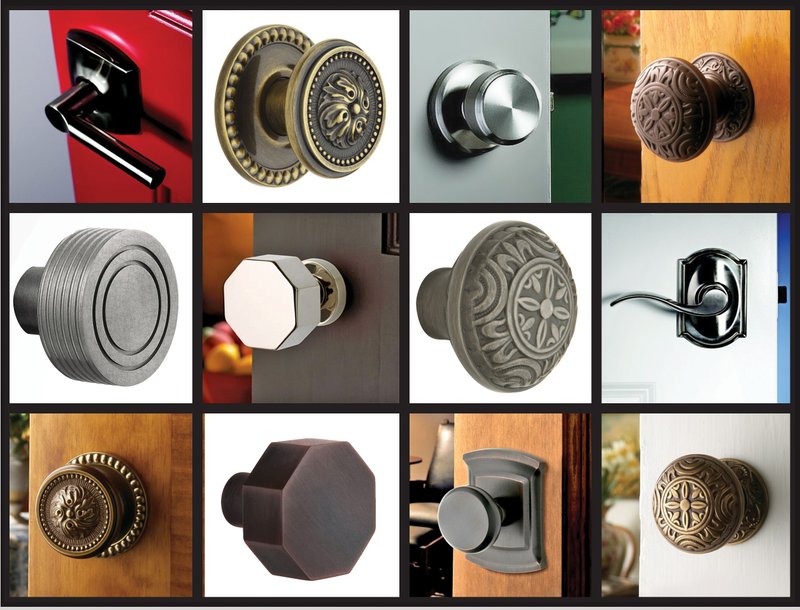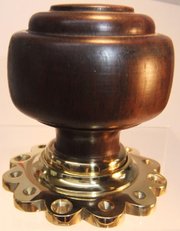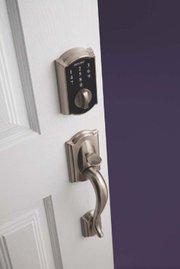A new doorknob is one of the easiest and least expensive ways to add a bright spot in place of the ordinary.
Ordinary probably came with the house. It works, and what more could a doorknob do? People are so accustomed to thinking the least of a doorknob; the name says it. "Knob," a lump.
But this practical handful of hardware can be so much more than dumb-as-a-doorknob. It can be art and ornament, or in designer talk, "jewelry for the house."
A quiz, for example, on terms that describe metallic finishes: "Polished chrome." "Satin nickel." "Venetian bronze." "Rustic pewter." Are these in reference to luxury cars -- or doorknobs?
Answer: Kwikset doorknobs. The brand is a mainstay of the neighborhood hardware store. Fanciers of elegant, hand-blown glass doorknobs look to the glass works of Brehat, an island off Brittany, in northwest France.
In between, the distinctive wares of dozens of doorknob makers are available in return for a bit of looking past the hardware aisle. Not just the big orange box store sells doorknobs, so do boutique shoppes -- decorative doorknobs to be found amid the blouses and button-downs.
So, too, any number of online sources -- and flea markets. Such a find as an 1885 Russell & Erwin ironworks doorknob counts as a treasure, something to enshrine on the website of Antique Doorknob Collectors of America (antiquedoorknobs.org).
Museums display old doorknobs as the emblems of bygone elegance. Some of today's choices make other statements of style. Mickey Mouse doorknob? Perfect for a squeaky door.
With these few tips, anybody can hobnob with the experts on doorknob selection:
• Round goes with anything. But shape is a choice: oval, square, rectangle, rosette. Easy on the hand can be what counts the most.
• Most doorknobs come in sets of two that match on either end of a rod called the spindle. The average spindle is made to fit through a door about 13/4 inches thick. Doors of uncommon breadth call for special fitting.
• Doorknobs that match give the house a planned-out look. Eclectic design allows for a grab-bag of door grabbers. The usual strategy is to match at least all the doorknobs in the same room.
Get a grip
What house would be an open door without a doorknob? Vancouver, British Columbia, is determined to find out.
Vancouver banned doorknobs from all new homes and apartments effective
in March 2014. The new code calls for easier-on-the-wrist door levers.
As goes Vancouver, the Vancouver Sun reported, so might "even the world." Up-and-down levers make sense to an aging population with stiff wrists and achy hands. Public buildings, hospitals and offices commonly opt for door levers, door handles and push plates, doing away with the troubles people have with cranky knobs.
Levers can be curved, and scrolled and finished to look no more industrial than a French door. But doorknobs can twist more than ligaments -- some turn heads.
Who pays attention to doorknobs? Important men do, according to author Liz Workman's book, Dr. Johnson's Doorknob: And Other Significant Parts of Great Men's Houses (Rizzoli).
The 18th-century English man of letters opened and closed his door with a twist, the book shows. President Franklin Delano Roosevelt favored a glass knob.
Authors Charles Dickens and Washington Irving shared a preference for plain white doorknobs -- or as Irving wrote about residential surroundings: "I value this delicious home feeling."
Dickens imagined a not-so-cozy door in A Christmas Carol. Ebenezer Scrooge has his door key in hand, ready to open the door, when the knocker appears to him as "not a knocker, but Marley's face."
Doors open to many an old superstition. American Colonists scratched hex marks on their door handles to keep out evil spirits. Even now, the door that opens and closes by itself is among the standard features of a haunted house.
Science may have the answer to keeping the door shut once and for all. "Smart Latch" is a new idea from the U.S. Department of Energy's Savannah River National Laboratory in South Carolina.
Awaiting patent, the acoustic gadget "listens" much the same as a person does, only better, for the latch to click shut. It sounds an alert if the door isn't closed all the way.
"We invented and patented the idea here at the national lab to solve a problem with door closures at our site," spokesman Dale Haas says. He envisions it could work as well in schools, nursing homes -- anyplace a door needs to be shut for sure.
The lab is looking for a manufacturer, Haas says. "We just need the right company to pick it up and run with it."
Curiouser and curiouser
Alice encounters one of the most curious doorknobs in the Disney cartoon version of Lewis Carroll's children's classic, Alice in Wonderland. The knob speaks up to say, "One good turn deserves another."
Real-life doorknobs do almost everything but talk. Shopper Alice could find doorknobs that light up, play music, and turn out in the shapes of hearts , snails, pistol grips (pull the trigger to open) -- even outstretched hands.
In Pembrokeshire, Wales, Tim and Angela Iles maintain a British tradition the American Colonists left behind: wooden doorknobs. Their Knobbs Hardware doorknobs are made of beech, oak and rosewood, each unique.
"Approximately half of our doorknobs are made as replicas to grace original doors in period properties," Angela Iles says, "but the rest go in all sorts of properties."
Some modern homes call for painted knobs, she says. The answer is Farrow & Ball paint, a nearly 100-year-old name in England.
These woodcrafters have yet to answer the knock from an American customer, she says, "but there's no reason why we can't."
Today's choice in doorknobs opens wide to a variety of styles: Gothic revival, Edwardian, Art Nouveau, Art Deco, from sleek and pearl inlaid to make-do on the cheap, displayed in show windows and sealed in blister packaging harder to open than the door to Fort Knox.
Today's HomeStyle cover pictures hardware from manufacturers including Schlage, Ashley Norton and Baldwin.
Prices are $10 and up to Katy, bar the door -- $50 and $60 for blown-glass, and more for antique crystal. Diamond-encrusted and solid gold doorknobs have been said to exist, but only sheiks know where to shop.
Practical considerations start with 2 cents' worth of advice.
How to know a knob
Doorknobs don't work by themselves.
(Well -- some do. A dummy knob simply screws to the door as a thing to grab, no latch, nothing more. The other extreme is the door that appears to have no grip at all, the catch mechanism being so well-hidden and flush with the surface.)
The traditional American doorknob takes a turn of the wrist, and so works the latch -- the bolt mechanism that keeps the door fastened shut.
• Keyed entry sets are for the front and back doors that need to lock. From outside, the locked door won't open without a key.
• Free sets are for interior doors that don't lock at all.
• Privacy sets are for bath and bedroom doors. The door locks from the inside. Outside, the knob has a little hole in the middle -- a way to trip the lock with a piece of wire in case of emergency.
• A storeroom set locks automatically every time the door is closed. From outside, the knob won't budge without a key. Inside, it opens freely, in case a person should accidently lock himself in the closet. These things happen.
It hinges on history
The invention of the doorknob had to await the invention of the door, and people did without doors for a long time.
The Egyptians had doors 5,000 years ago. But most of the world made do with animal hides and weaving to cover passageways, according to "Doorknobs through history" on the Schlage door lock website.
Kings strode in royal manner through wooden doors hung by straps and bolts in the Middle Ages. Eventually, even commoners had doors.
Doors made possible a new idea in home design -- individual rooms. Before, the entire household had lived in one big space. A room to one's self called for a door, and then a way to keep people from barging through it.
Door bars and hand-forged hasps and simple thumb latches kept the door closed prior to the Industrial Revolution. After came the machine-made mechanical latch -- a marvel that worked at the merest rotation of a thing, being a knob and all, called the doorknob.
More than 100 U.S. patents were granted for doorknobs between the door-busting years of 1830 to 1873, according to Schlage (rhymes with "vague").
The Chicago Exposition of 1876 taught Americans what the English and French could have whispered through a crack in the door -- that a doorknob could be better than a blob of potter's clay.
With doorknobs of cut glass and painted china, and veneers of bronze and brass, came the idea of decorative hardware. So now, as ever more new and attractive designs come rapping, the doorknob is a reminder of how to imagine the possibilities:
Be open.
HomeStyle on 01/31/2015



